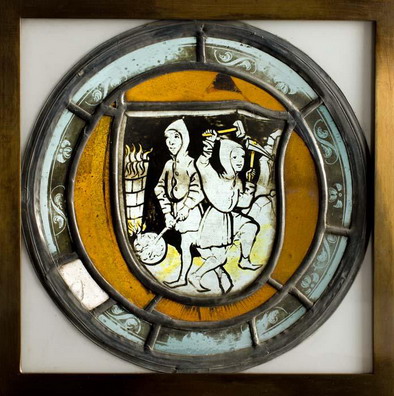
15
彩色拼花窗玻璃
波希米亚,15世纪末
无色透明玻璃,银染色,绘黑色珐琅彩;直径 21 cm
编号 10 425
1906年布拉格的沃伊切克·兰尼捐赠
1983年由约瑟夫·伊日奇卡修复和重新组装
这块窗玻璃来自库特纳霍拉(德语:库滕贝格,直译“矿山”)的圣芭芭拉教堂,图案是正在采矿的矿工。库特纳霍拉富含银矿,是波希米亚第二大城市,仅次于布拉格,但在经济上和政治上独占鳌头。15世纪最后30多年至16世纪早期,即波兰雅盖隆王朝(1471-1526)统治时期,库特纳霍拉最为繁荣。当地银矿为皇室的建筑工程提供了充足的资金。银矿的利润也让矿业大亨们能够建豪宅、造礼拜堂,并且大肆装修。库特纳霍拉的财富给人类活动的许多领域带来了繁荣;同时也涌现了一批珍稀彩图手稿,极为出色。
Stained-glass window pane
Bohemia, end of 15th century
Colorless glass, silver-stained, painted in black enamel; Diameter: 21 cm
Inv. no. 10?425
Donated in 1906 by Vojtěch Lanna
Restored and newly framed in 1983 by Josef Ji?i?ka
This window pane featuring a motif of miners at work comes from St. Barbara’s Church in Kutná Hora (Kuttenberg in German, literally “Mining Mountain”). As the very name suggests, the location was rich in silver mines and was the second largest, and economically and politically most important city in Bohemia after Prague. Kutná Hora reached the peak of its prosperity under the reign of the Polish Jagiellonian Dynasty (ruled 1471–1526) in the final third of the 15th and the early 16th centuries. The silver mined in Kutná Hora served to finance royal construction projects. In turn, the profits enabled the mining entrepreneurs to construct their own stately residences, build chapels and expend huge sums of money on furnishing them. Kutná Hora’s wealth brought prosperity to many fields of human activity; this is where remarkable and still highly-prized illuminated manuscripts were produced.
HB | 